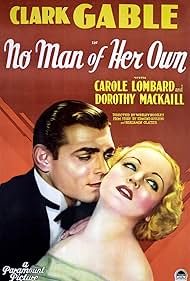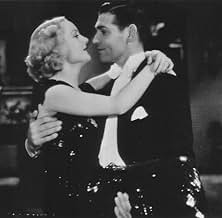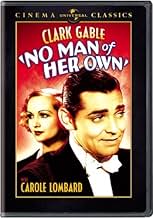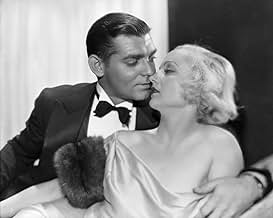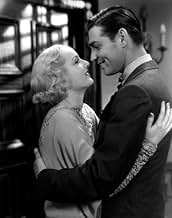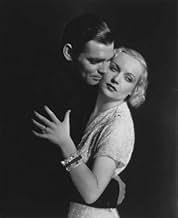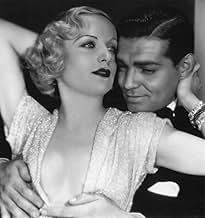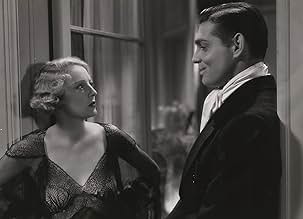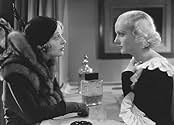IMDb RATING
6.6/10
1.8K
YOUR RATING
An on-the-lam New York card shark marries a small-town librarian who thinks he's a businessman.An on-the-lam New York card shark marries a small-town librarian who thinks he's a businessman.An on-the-lam New York card shark marries a small-town librarian who thinks he's a businessman.
- Awards
- 1 win total
Sammy Blum
- Door to Door Salesman
- (uncredited)
Mary Bracken
- High School Girl
- (uncredited)
Wallis Clark
- Thomas Laidlaw
- (uncredited)
Lillian Harmer
- Mattie
- (uncredited)
Margaret Marquis
- Girl in the Library
- (uncredited)
Featured reviews
No Man of Her Own is a pleasant film, nothing terribly bad or terribly good about it. It is remembered today as the only pairing of that star-crossed couple Clark Gable and Carole Lombard. At the time this was made Gable and Lombard were not an item. They became one about four or five years after No Man of Her Own was filmed. It's not on the top 10 list of either star.
Gable is a gambler/con artist who's forced by circumstance to beat it out of New York and he flees for a small suburb where he meets librarian Carole Lombard and marries her. That's as far as I'm going with the telling of the plot.
Lombard was with Paramount at the time this was made and Gable was on loan out from MGM. There's none of the Lombard we knew and loved in such classics as Twentieth Century or My Man Godfrey here. She's a pleasant enough screen heroine though. Gable does well in his part, but doesn't set the world on fire.
If someone had only predicted that Gable and Lombard and their marriage would be come legendary. I'm sure they would have been given a much better film property. I always felt that if Lombard had not been killed in that plane crash in 1942 she would have eventually signed with MGM and L.B. Mayer would have paired her with Gable in the way Katharine Hepburn signed with MGM after the success of Woman of the Year with Spencer Tracy. You might have had a few films to remember Gable and Lombard by.
Gable is a gambler/con artist who's forced by circumstance to beat it out of New York and he flees for a small suburb where he meets librarian Carole Lombard and marries her. That's as far as I'm going with the telling of the plot.
Lombard was with Paramount at the time this was made and Gable was on loan out from MGM. There's none of the Lombard we knew and loved in such classics as Twentieth Century or My Man Godfrey here. She's a pleasant enough screen heroine though. Gable does well in his part, but doesn't set the world on fire.
If someone had only predicted that Gable and Lombard and their marriage would be come legendary. I'm sure they would have been given a much better film property. I always felt that if Lombard had not been killed in that plane crash in 1942 she would have eventually signed with MGM and L.B. Mayer would have paired her with Gable in the way Katharine Hepburn signed with MGM after the success of Woman of the Year with Spencer Tracy. You might have had a few films to remember Gable and Lombard by.
I mainly got this out because I wanted to see some eye candy: Clark Gable and the wonderful Carole Lombard (plus all the wonderful '30s fashions). It's a good screwball comedy, but a little boring until Carole Lombard comes into the picture. I found some scenes unnecessary and a little boring, but there are some genuinely good scenes with Lombard in it - she really is the queen of screwball comedies. Her comic timing is wonderful. I was very much impressed. Clark is as usual very handsome and sexy. I'm not familiar with the pre Hollywood code but I guess this would be fairly risqué as Carole is shown in her underwear. A good movie, nothing special, but fun to watch.
10lora64
This is a pleasant kind of tale, easygoing and amusing. Clark Gable as the gambler Babe Stewart, meets quiet (i.e. repressed) librarian Connie Randall, played by Carole Lombard. At the library, when he corners her amongst the bookshelves, she asks, "Do you like Shakespeare?" and I like Gable's reply, "Oh Shakespeare's alright but sometimes you just don't feel like Shakespeare" says he gazing deep into her eyes. Just an amusing moment.
After a hesitant start they inevitably fall in love and impulsively decide to wed, and thereafter the plot unfolds. Gable resumes his dishonest card sniping activities (i.e. racket), however this clashes with the wifey on the domestic front. In time he plans to reform his ways, "Things gotta be different from now on," he tells the police, but there are complications ahead.
It's very interesting to see a younger Clark Gable who even at this stage was well established in his screen presence. And Carole Lombard couldn't be more beautiful! Great viewing for the fans of Gable and Lombard.
After a hesitant start they inevitably fall in love and impulsively decide to wed, and thereafter the plot unfolds. Gable resumes his dishonest card sniping activities (i.e. racket), however this clashes with the wifey on the domestic front. In time he plans to reform his ways, "Things gotta be different from now on," he tells the police, but there are complications ahead.
It's very interesting to see a younger Clark Gable who even at this stage was well established in his screen presence. And Carole Lombard couldn't be more beautiful! Great viewing for the fans of Gable and Lombard.
I think other reviewers heard that this was supposed to be "a screwball comedy" and ran with that idea because they didn't know what else to say. I didn't see anything light and fluffy or "screwball" about it. Perhaps "offbeat" might be a more apt characterization. Gable's interpretation of the New York gambler was interesting because something in his usual sort of charming yet manly approach was notably lacking. He possessed the irreverent and utterly confident attitude we have come to associate with his other performances, but a number of his youthful facial expressions were of a more complex and unfamiliar sort. The reserved yet knowing way he nodded howdy-do upon introduction to Lombard's mother and then her father was especially amusing, I thought. There were also the many intriguing interactions with the actress, herself, particularly with regard to the touchy subjects of marriage and stability. The oft-subtle writing in this flick made for several interesting moments and both actors were fully up to the challenge of a sensitive and intelligent interpretation of the script. It is also interesting that there was allegedly no actual romantic attachment between these two because the chemistry was already quite evident. It must have miffed a number of the more glamorous Hollywood starlets when Lombard won Gable's heart in real life. Although beautiful, she wasn't glamorous, nor was she pretentious and affected, but more like the girl next door. I read that the library scene (where Gable sent her up a ladder as an excuse to examine her legs) single-handedly started some sort of decency league in the motion picture industry. The bluenoses are always with us, aren't they, shoving their childish attitudes down the throats of the adults. Much more risqué was the scene in which Lombard's predecessor, Kay, appeared on screen in a see-through nightgown that revealed critical aspects of her anatomy, both front and back. The thirties obviously were a much less prudish time because her gentlemen friends didn't even pay much attention, at least not overtly, and scenes such as that would not appear in movies again until the sixties. We've noted a similar sensuality in other movies from that era. As a society, we keep coming back to the cultural doldrums, where they are pushing wealth or war or something else that always seems to further the interests of those in control. Unconventional times like the thirties and the sixties are few and far between. It showed in this movie.
The perks of this movie are many: a fun screwball comedy set-up involving card-sharking, two beautiful stars looking young and fantastic (you'll see why women first fell in love with Clarke Gable, and found him ideal to play Rhett Butler), the only on screen pairing of said stars, who were to become husband and wife. He would love her long after she died in a tragic plane accident on a mission to sell war bonds (i think it was). Another perk is the pre-production code raunchiness. You may notice that any movie made between 1930-1934 seems a lot racier than movies made before or after then. This is because in this short period there was no censorship of movie content, and no rules to say what you could and could not show on screen. This was left to the filmmaker's discretion. So you'll find shots of Gable in the shower, and Lombard also, though she is much less exposed. Not actual nudity, of course, but open sexiness banished from movies from 1934 till whenever the Hayes code ended - such as Gable asking Lombard the librarian to fetch him a book from the top shelf so she has to climb up the ladder and he can look at her legs.
If you've never seen a screwball comedy, you might be pleasantly surprised. They're all pretty fun. Bringing up Baby with Cary Grant and Katherine Hepburn is probably the best one. They were all the rage in the 30's, and Carole Lombard was the ideal screwball heroine. To be recommended.
If you've never seen a screwball comedy, you might be pleasantly surprised. They're all pretty fun. Bringing up Baby with Cary Grant and Katherine Hepburn is probably the best one. They were all the rage in the 30's, and Carole Lombard was the ideal screwball heroine. To be recommended.
Storyline
Did you know
- TriviaAlthough Carole Lombard and Clark Gable later became one of Hollywood's most famous couples, they were completely indifferent to one another during the making of this film. It was not until several years later that they met again and fell in love and got married. This was Gable and Lombard's only film together.
- GoofsEarly in the movie, Babe takes a taxi; there is a very clear view of the front hood of the cab, with the telephone number of the cab company. Later in the movie, Babe calls his wife with his new office phone number. He looks at the dial of his new phone and gives her the telephone number of the cab company.
- Crazy creditsThe cast is shown on a hand of poker cards, with the leads' faces shown as the various cards.
- ConnectionsFeatured in The Love Goddesses (1965)
- How long is No Man of Her Own?Powered by Alexa
Details
- Runtime1 hour 25 minutes
- Color
- Aspect ratio
- 1.37 : 1
Contribute to this page
Suggest an edit or add missing content

